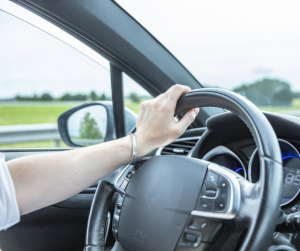New Jersey Future Blog
Transportation for Everyone: Designing Safe, Sustainable Options for Women
March 17th, 2023 by Hannah Reynolds
 Last year, New Jersey Future explored how women and gender nonconforming people face disproportionate obstacles when accessing public transit, biking, or walking as forms of transportation. We found that 65% of women-identifying people have experienced street harassment in their lives and that 99% of the NYC public transit riders who reported sexual harassment on the subway identified as female. We learned that people who identify as women face a higher risk of assault when walking, biking, or riding public transit, and that low-income women often face the highest dependence on these modes of transportation. While these alternatives to driving cars are typically more sustainable and affordable than their gas-powered counterparts, the potential costs of walking, biking, or taking public transit for women—namely the inherent threat to personal safety—could be taken as an implication that cars are the safest option for women-aligned people to get around. However, cars are unsafe for everyone: drivers, pedestrians, bikers, and especially, people assigned female at birth (AFAB).1 As cars get bigger and heavier, drivers of smaller, more sustainable cars face heightened risk in collisions. At the same time, drivers of larger vehicles are more prone to rollover crashes and hitting pedestrians due to increased blindspots and limited fields of vision. Beyond this, private automobiles manufacturers boast annual safety awards as they deliver safer and safer automobiles, it is important to acknowledge that automobile safety is also subject to the same biases that prioritize men found throughout our economy and society.
Last year, New Jersey Future explored how women and gender nonconforming people face disproportionate obstacles when accessing public transit, biking, or walking as forms of transportation. We found that 65% of women-identifying people have experienced street harassment in their lives and that 99% of the NYC public transit riders who reported sexual harassment on the subway identified as female. We learned that people who identify as women face a higher risk of assault when walking, biking, or riding public transit, and that low-income women often face the highest dependence on these modes of transportation. While these alternatives to driving cars are typically more sustainable and affordable than their gas-powered counterparts, the potential costs of walking, biking, or taking public transit for women—namely the inherent threat to personal safety—could be taken as an implication that cars are the safest option for women-aligned people to get around. However, cars are unsafe for everyone: drivers, pedestrians, bikers, and especially, people assigned female at birth (AFAB).1 As cars get bigger and heavier, drivers of smaller, more sustainable cars face heightened risk in collisions. At the same time, drivers of larger vehicles are more prone to rollover crashes and hitting pedestrians due to increased blindspots and limited fields of vision. Beyond this, private automobiles manufacturers boast annual safety awards as they deliver safer and safer automobiles, it is important to acknowledge that automobile safety is also subject to the same biases that prioritize men found throughout our economy and society.
While driving—unlike walking, biking, or taking public transportation—allows women-aligned people to get from place to place with minimal threat of harassment or assault, studies show that cars too are not designed with women’s safety in mind. Presently, safety features like seat belts and airbags and even dashboards are created to best fit the safety needs of someone the size of an average man in the 1970s, an outdated measure which has resulted in disproportionate injuries in people who are AFAB, aging adults, people who are overweight or obese, children, and other diverse human bodies. Beyond cisgender women being smaller on average than men, the anatomical differences between biological males and females heighten the risk of serious injury and death for people who are AFAB in crashes. People with female anatomy tend to sit further forward when driving, so that their legs can reach the pedals, and they tend to sit more upright in order to see over the dashboard. This means that biologically-female people are considered “out of position drivers,” meaning that most people assigned female at birth (over half the population) tend to sit outside the position that is optimized for driver safety—increasing their risk of internal injury in frontal collisions. As a result, a biological woman in the driver’s seat is 73% more likely to be seriously injured if the car crashes and 17% more likely to die than a male driver. Women are also more likely to experience whiplash in rear-end collisions especially, given their lighter weight, less muscle composition in the neck and upper torso, and varying spinal columns compared with men. Slow-speed crash tests with biological women indicate that they are thrown forward harder and faster than biological men in rear-end collisions, given their smaller size and body composition. Overall, car design prioritizes male drivers in terms of safety and structure, posing heightened risks for cisgender women.
While safety features in cars are predominantly designed for average-sized men, the disregard for women’s safety in automobile manufacturing extends beyond design: crash testing also prioritizes male safety. Crash-test dummies, first introduced in the 1950s, are most commonly based off of the average cisgender male—at 5 feet, 10 inches tall and weighing 168 pounds, with the muscle composition and column associated with biological males. It was not until 2011 that ‘female’ crash dummies were first implemented, but these dummies are merely modeled after male dummies scaled down to the 5th percentile. As a result, ‘female’ dummies fail to accurately model the average female geometry (shape and form of the torso), muscle mass and distribution, ligament size, spinal alignment and vertebrae spacing, body sway and dynamic responses to trauma, and bone density. All of these factors impact how a biologically-female body experiences a car crash, which without adequate testing and design of appropriate safety features can give way to serious injury and death.
Even more appalling, however, are the outdated assumptions about women-aligned people who use automobiles for transportation. Despite the fact that as of 2019, more than half the licensed drivers in America are woman-aligned people, ‘female’ crash dummies are predominantly tested in the passenger and back seats. There is an assumption—dating back to the 1950s, but implemented in 2011, when ‘female’ crash dummies were first mandated—that those identified as women are not primarily drivers, so prioritizing safety in passenger positions is sufficient in safety testing. At the same time, using a baseline ‘average’ size from 1970 is unrealistic and inadequate, as more drivers today are overweight or obese. Further, testing pregnant crash dummies is not mandated by the US, despite the existence of dummies modeled after pregnant people—a glaring safety concern for both birthing people and their unborn children. Car crashes are the number one cause of fetal death from maternal trauma, yet 62% of third-trimester parents cannot fit in a standard seatbelt. Through all this, it appears that car manufacturers continue to perpetuate outdated understandings of female autonomy and fail to consider and design for the needs of biologically-female drivers, effectively putting women’s safety at risk.
All in all, women experience disproportionate safety risks in most, if not all, forms of transportation, whether mass transit, walking, biking, or driving. As a result, it is crucial to address the systemic barriers and threats which endanger women’s lives as they move from place to place, by building infrastructure that is accessible and reliable for the needs of women. While there has been some movement by legislators to require enhanced safety testing measures for biologically-female drivers—including the Furthering Advanced and Inclusive Research for Crash Tests Act (FAIR Crash Tests Act) proposed in 2021—there is a long way to go until women are adequately protected in vehicles, both in practice and in the law. Whether creating wide, well-lit streets for walking and biking, increasing reliability and accessibility of mass transit options like trains, buses, and the metro, or designing EVs to also meet women’s safety needs, there needs to be urgent investment and legislation around women’s safety and reliable, accessible, and sustainable transportation.
__________________
1Language shapes the way we think and understand the world. Note: In this blog, the terms “woman” or “female” are predominantly used in a limited sense, focused on people born with biologically-female anatomies. In recognition of Women’s History Month, this blog is focused on the experiences of biological, cisgender women, but these findings also are applicable to transgender men and nonbinary people assigned female at birth. The safety concerns related to automobile crash testing and design primarily impact people with female anatomy, but we recognize that anatomy and gender identity are distinct and not necessarily correlated. Therefore, we use language such as: assigned female at birth, biologically female, cisgender women, etc. to be as equitable as possible. We also refer to people who can give birth as pregnant or birthing people, to recognize that not all people with the ability to give birth identify as female. When referring to those identifying as female (regardless of anatomy), we specify woman-identifying or those who identify as female, which includes transgender women.
Related Posts
Tags: equity, Pedestrian, safe transportation, safety, sustainable, sustainable transportation, Transit, Transportation, vehicle, vehicles, Women’s History Month
















